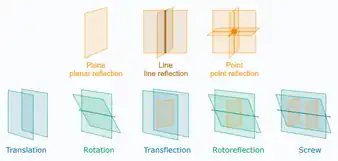
Plane-based Geometric Algebra is an application of Clifford algebra to modelling planes, lines, points, and rigid transformations. Generally this is with the goal of solving engineering problems involving these elements and their intersections, projections, and their angle from one another in 3D space.[1] Originally growing out of research on spin groups,[2][3] it was developed with applications to robotics in mind.[4][5] It has since been applied to machine learning,[6] rigid body dynamics,[7] and computer science,[8] especially computer graphics.[9][10] It is usually combined with a duality operation into a system known as "Projective Geometric Algebra", see below.
Plane-based geometric algebra takes planar reflections as basic elements, and constructs all other transformations and geometric objects out of them. In technical language: it identifies planar reflections with the grade-1 elements of a Clifford Algebra, that is, elements that are written with a single subscript such as "". With some rare exceptions described below, the algebra is almost always Cl3,0,1(R), meaning it has three basis grade-1 elements whose square is and a single basis element whose square is .
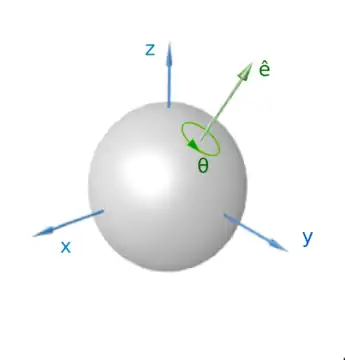
Plane-based GA subsumes a large number of algebraic constructions applied in engineering, including the axis–angle representation of rotations, the quaternion and dual quaternion representations of rotations and translations, the plücker representation of lines, the point normal representation of planes, and the homogeneous representation of points. Dual Quaternions then allow the screw, twist and wrench model of classical mechanics to be constructed.[7]
The plane-based approach to geometry may be contrasted with the approach that uses the cross product, in which points, translations, rotation axes, and plane normals are all modelled as "vectors". However, use of vectors in advanced engineering problems often require subtle distinctions between different kinds of vector because of this, including Gibbs vectors, pseudovectors and contravariant vectors. The latter of these two, in plane-based GA, map to the concepts of "rotation axis" and "point", with the distinction between them being made clear by the notation: rotation axes such as (two lower indices) are always notated differently than points such as (three lower indices).
All objects considered below are still "vectors" in the technical sense that they are elements of vector spaces; however they are not (generally) vectors in the sense that one could meaningfully take their cross product - so it is not informative to visualize them as arrows. To avoid conflict over different algebraic and visual connotations coming from the word 'vector', this article will avoid the use of the word.
Construction

Plane-based geometric algebra starts with planes and then constructs lines and points by taking intersections of planes. Its canonical basis consists of the plane such that , which is labelled , the , which is labelled , and the plane, .
Other planes may be obtained as weighted sums of the basis planes. for example, would be the plane midway between the y- and z-plane. In general, combining two geometric objects in plane-based GA will always be as a weighted average of them – combining points will give a point between them, as will combining lines, and indeed rotations.
For any pair of elements A and B, their geometric product is the transformation A followed by the transformation . The result of this will not in general be an object of the same type as A and B – but it will still be an object within plane-based GA. For example:
This equation can be interpreted geometrically as stating that if we take (which is a planar reflection in the plane) and (which is a 180-degree rotation around the x-axis), and take their geometric product, we obtain , which is a point reflection in the origin. Transform composition – the geometric product – should not be confused with transform application, which is implemented with the sandwich product, see below.
This geometric interpretation is usually combined with the following assertion:
The geometric interpretation of the first three defining equations is that if we perform the same planar reflection twice we get back to where we started; e.g. a grade-1 element (plane) multiplied by itself results in the identity function, "". The statement that is more subtle.

Elements at infinity
The algebraic element represents the plane at infinity. It behaves differently from any other plane – intuitively, it can be "approached but never reached". In 3 dimensions, can be visualized as the sky. Lying in it are the points called "vanishing points", or alternatively "ideal points", or "points at infinity". Parallel lines meet one another at such points.
Lines at infinity also exist; the horizon line is an example of such a line. For an observer standing on a plane, all planes parallel to the plane they stand on meet one another at the horizon line. Algebraically, if we take to be the ground, then will be a plane parallel to the ground. These two parallel planes meet one another at the line-at-infinity .
Most lines, for examples , can act as axes for rotations; in fact they can treated as imaginary quaternions. But lines that lie in the plane-at-infinity , such as the line , cannot act as axes for a "rotation". Instead, these are axes for translations, and instead of having an algebra resembling complex numbers or quaternions, their algebraic behaviour is the same as the dual numbers, since they square to 0. Combining the three basis lines-through-the-origin , , , which square to , with the three basis lines at infinity , , gives the necessary elements for the Dual Quaternions.
Derivation of other operations from the geometric product
There are several useful products that can be extracted from the geometric product, similar to how the dot product and cross product were extracted from the quaternion product. These include:
- The transformation from toward is , with and again being points, lines or planes; here, is the reverse (essentially the inverse). The transformation will be by twice the angle or distance between and ; if a transformation by the exact distance or angle is required, it can be obtained with the dual quaternion exponential and logarithm.
- The meet (or "wedge product") , which is useful for taking intersections of objects; for example, the intersection of the plane with the line is the point .
- The inner product , which is useful for taking projections of objects onto other objects; the projection of onto is – this formula holds whether the objects are points, lines, or planes. It is a generalization of the dot product.
- The norm of is and is denoted . It can be used to take angles between most objects: the angle between and , whether they are lines or planes, is . This assumes that and both have norm , eg .
- Application of any rigid transformation (dual quaternion) or reflection to any object, including points, lines, planes and indeed other rigid transformations, is , where is object to be transformed; this is the "sandwich product".
- The commutator product , defined as for lines , will give the unique line that is orthogonal to both.
For example, recall that is a plane, as is . Their geometric product is their "reflection composition" – a reflection in followed by a reflection in , which results in the dual quaternion . But this may be more than is desired; if we wish to take only the intersection line of the two planes, we simply need to look at just the "grade-2 part" of this result, e.g. the part with two lower indices . The information needed to specify that the intersection line is contained inside the transform composition of the two planes, because a reflection in a pair of planes will result in a rotation around their intersection line.
Interpretation as algebra of reflections
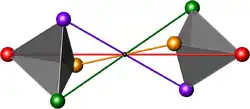
The algebra of all distance-preserving transformations (essentially, rigid transformations and reflections) in 3D is called the Euclidean Group, . By the Cartan–Dieudonné theorem, any element of it can be written as a series of reflections in planes.
In plane-based GA, essentially all geometric objects can be thought of as a transformation. Planes such as are planar reflections, points such as are point reflections, and lines such as are line reflections - which in 3D are the same thing as 180-degree rotations. The identity transform is the unique object that is constructed out of zero reflections. All of these are elements of .
Some elements of , for example rotations by any angle that is not 180 degrees, do not have a single specific geometric object which is used to visualize them; nevertheless, they can always be thought of as being made up of reflections, and can always be represented as a linear combination of some elements of objects in plane-based geometric algebra. For example, is a slight rotation about the axis, and it can be written as a geometric product (a transform composition) of and , both of which are planar reflections intersecting at the line .
In fact, any rotation can be written as a composition of two planar reflections that pass through its axis; thus it can be called a 2-reflection.[11] Rotoreflections, glide reflections, and point reflections can also always be written as compositions of 3 planar reflections and so are called 3-reflections. The upper limit of this for 3D is a screw motion, which is a 4-reflection. For this reason, when considering screw motions, it is necessary to use the grade-4 element of 3D plane-based GA, , which is the highest-grade element.
Geometric interpretation of geometric product as "cancelling out" reflections
_and_a_translation_(right).gif)
A reflection in a plane followed by a reflection in the same plane results in no change. The algebraic interpretation for this geometry is that grade-1 elements such as square to 1. This simple fact can be used to give a geometric interpretation for the general behaviour of the geometric product as a device that solves geometric problems by "cancelling mirrors".[11]
To give an example of the usefulness of this, suppose we wish to find a plane orthogonal to a certain line L in 3D and passing through a certain point P. L is a 2-reflection and is a 3-reflection, so taking their geometric product PL in some sense produces a 5-reflection; however, as in the picture below, two of these reflections cancel, leaving a 3-reflection (sometimes known as a rotoreflection). In the plane-based geometric algebra notation, this rotoreflection can be thought of as a planar reflection "added to" a point reflection. The plane part of this rotoreflection is the plane that is orthogonal to the line L and the original point P. A similar procedure can be used to find the line orthogonal to a plane and passing through a point, or the intersection of a line and a plane, or the intersection line of a plane with another plane.
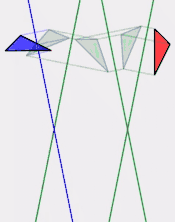
Rotations and translations as even subalgebra
Rotations and translations are transformations that preserve distances and handedness (chirality), e.g. when they are applied to sets of objects, the relative distances between those objects does not change; nor does their handedness, which is to say that a right-handed glove will not turn into a left-handed glove. All transformations in 3D euclidean plane-based geometric algebra preserve distances, but reflections, rotoreflections, and transflections do not preserve handedness.
Rotations and translations do preserve handedness, which in 3D Plane-based GA implies that they can be written as a composition of an even number of reflections. A rotations can thought of as a reflection in a plane followed by a reflection in another plane which is not parallel to the first (the quaternions, which are set in the context of PGA above). If the planes were parallel, composing their reflections would give a translation.
Rotations and translations are both special cases of screw motions, e.g. a rotation around a line in space followed by a translation directed along the same line. This group is usually called SE(3), the group of Special (handedness-preserving) Euclidean (distance-preserving) transformations in 3 dimensions. This group has two commonly-used representations that allow them to be used in algebra and computation, one being the 4×4 matrices of real numbers, and the other being the Dual Quaternions. The Dual Quaternion representation (like the usual quaternions) is actually a double cover of SE(3). Since the Dual Quaternions are algebraically closed and are made from an even number of basis elements in, they are called the even subalgebra of 3D euclidean plane-based geometric algebra. The word 'spinor' is sometimes used to describe this subalgebra.[12][13]
Describing rigid transformations using planes was a major goal in the work of Camille Jordan.[14] and Michel Chasles[15] since it allows the treatment to be dimension-independent.
Generalizations
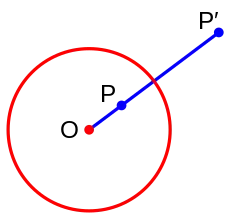
Inversive Geometry
Inversive geometry is the study of geometric objects and behaviours generated by inversions in circles and spheres. Reflections in planes are a special case of inversions in spheres, because a plane is a sphere with infinite radius. Since plane-based geometric algebra is generated by composition of reflections, it is a special case of inversive geometry. Inversive geometry itself can be performed with the larger system known as Conformal Geometric Algebra(CGA), of which Plane-based GA is a subalgebra.
CGA is also usually applied to 3D space, and is able to model general spheres, circles, and conformal (angle-preserving) transformations, which include the transformations seen on the Poincare disk.[16] It can be difficult to see the connection between PGA and CGA, since CGA is often "point based", although some authors take a plane-based approach to CGA[11] which makes the notations for Plane-based GA and CGA identical.
Projective Geometric Algebra
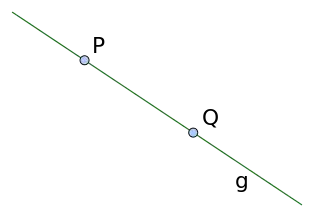
Plane-based geometric algebra is able to represent all Euclidean transformations, but in practice it is almost always combined with a dual operation of some kind to create the larger system known as "Projective Geometric Algebra", PGA.[17][18][19] Duality, as in other Clifford and Grassmann algebras, allows a definition of the regressive product. This is extremely useful for engineering applications - in plane-based GA, the regressive product can join a point to another point to obtain a line, and can join a point and a line to obtain a plane. It has the further convenience that if any two elements (points, lines, or planes) have norm (see above) equal to , the norm of their regressive product is equal to the distance between them. The join of several points is also known as their affine hull.
Variants of duality and terminology
There is variation across authors as to the precise definition given for dual that is used to define the regressive product in PGA. No matter which definition is given, the regressive product functions to give completely identical outputs; for this reason, precise discussion of the dual is usually not included in introductory material on projective geometric algebra. There are significant conceptual and philosophical differences:
- The Hodge dual relates elements of plane-based geometric algebra to other elements of plane based geometric algebra (eg, other euclidean transformations); for example, the Hodge dual of a planar reflection is a point reflection. PGA was originally defined using the Hodge dual.[4]
- The Projective dual also maps planes to points, but it is not the case that both are reflections; instead, the projective dual switches between the space that plane-based geometric algebra operates in and a different, non-euclidean space, see dual space. For example, planes in plane-based geometric algebra, which perform planar reflections, are mapped to points in dual space which are involved in collineations. Different authors have termed the plane-based GA part of PGA "Euclidean space"[20] and "Antispace".[10] This form of duality, combined with the fact that geometric objects are represented homogeneously (meaning that multiplication by scalars does not change them), is the reason that the system is known as "Projective" Geometric Algebra (even though it does not contain the full projective group, unlike Conformal Geometric Algebra, which contains the full conformal group).
- Alternatively, conformal geometric algebra can be used (since plane-based GA is a subalgebra of CGA), but defining the PGA regressive product within it is complicated by the fact that CGA has its own regressive product, which is a different product, informally because the join of three points in CGA is a circle, whereas in PGA it is a plane. Another problem is that PGA "points" have a fundamentally different algebraic representation than CGA points; to compare the two algebras, PGA points must be recognized as CGA point pairs, where the point pair has a point at infinity. To get around this problem, some authors define the projective dual in CGA as an exchange of two different PGA-isomorphic subalgebras within it;[21] it is also possible to define the Hodge dual within CGA, but using the CGA element , which is the PGA pseudoscalar .
Projective geometric algebra of non-euclidean geometries and Classical Lie Groups in 3 dimensions
To a first approximation, the physical world is euclidean, i.e. most transformations are rigid; Projective Geometric Algebra is therefore usually is based on Cl3,0,1(R), since rigid transformations can be modelled in this algebra. However, it is possible to model other spaces by slightly varying the algebra.[20]
| Geometric space | Transformation group | Apparent "plane at infinity" squares to | Names for handedness-preserving subgroup (even subalgebra) | Notes |
|---|---|---|---|---|
| Euclidean | Pin(3, 0, 1)
Cl3,0,1(R) |
0 | Dual quaternions; Spin(3, 0, 1);
double cover of rigid transformations |
Most important for engineering applications, since transformations are rigid; also most "intuitive" for humans |
| Elliptic | Pin(4, 0, 0)
Cl4,0,0(R) |
1 | Split-biquaternions; Spin(4, 0, 0);
double cover of 4D rotations |
Also known as "spherical geometry". Analogous to Cl3,0,0(R); provides a model the Gnonomic world map projection. Includes Poincaré duality. |
| Hyperbolic | Pin(3, 1, 0)
Cl3,1,0(R) |
−1 | Complex quaternion; Spin(3, 1, 0);
double cover of Lorentz group |
Also known as "saddle geometry". Group can perform rotations and spacetime boosts, a.k.a. boosts. (2,1,0) is equivalent to the Klein disk model of 2D hyperbolic geometry. |

In these systems, the points, planes, and lines have the same coordinates that they have in plane-based GA. But transformations like rotations and reflections will have very different effects on the geometry. In all cases below, the algebra is a double cover of the group of reflections, rotations, and rotoreflections in the space.
All formulae from the euclidean case carry over to these other geometries – the meet still functions as a way of taking the intersection of objects; the geometric product still functions as a way of composing transformations; and in the hyperbolic case the inner product become able to measure hyperbolic angle.
All three even subalgebras are classical Lie groups (after taking the quotient by scalars). The associated Lie algebra for each group is the bivectors of the Clifford algebra,[22] not taking the quotient by scalars.
References
- ↑ .A Swift Introduction to Projective Geometric Algebra, retrieved 2023-09-09
- ↑ Porteous, Ian R. (1981-02-05). Topological Geometry. Cambridge University Press. doi:10.1017/cbo9780511623943. ISBN 978-0-521-23160-2.
- ↑ Brooke, J. A. (1978-05-01). "A Galileian formulation of spin. I. Clifford algebras and spin groups". Journal of Mathematical Physics. 19 (5): 952–959. Bibcode:1978JMP....19..952B. doi:10.1063/1.523798. ISSN 0022-2488.
- 1 2 Selig, J. M. (September 2000). "Clifford algebra of points, lines and planes". Robotica. 18 (5): 545–556. doi:10.1017/S0263574799002568. ISSN 0263-5747. S2CID 28929170.
- ↑ "Geometric Fundamentals of Robotics". Monographs in Computer Science. 2005. doi:10.1007/b138859. ISBN 978-0-387-20874-9.
- ↑ "Research – CliffordLayers". microsoft.github.io. Retrieved 2023-08-10.
- 1 2 Hadfield, Hugo; Lasenby, Joan (2020), "Constrained Dynamics in Conformal and Projective Geometric Algebra", Advances in Computer Graphics, Lecture Notes in Computer Science, Cham: Springer International Publishing, vol. 12221, pp. 459–471, doi:10.1007/978-3-030-61864-3_39, ISBN 978-3-030-61863-6, S2CID 224820480, retrieved 2023-09-09
- ↑ Dorst, Leo; Fontijne, Daniel; Manning, Stephen Joseph (2009). Geometric algebra for computer science: an object-oriented approach to geometry. The Morgan Kaufmann series in computer graphics (2nd corrected printing ed.). Amsterdam: Morgan Kaufmann/Elsevier. ISBN 978-0-12-374942-0.
- ↑ Dorst, Leo (2010). Geometric algebra for computer science: an object-oriented approach to geometry. Elsevier, Morgan Kaufmann. ISBN 978-0-12-374942-0. OCLC 846456514.
- 1 2 Lengyel, Eric (2016). Foundations of game engine development : Volume 1: mathematics. Lincoln, California. ISBN 978-0-9858117-4-7. OCLC 972909098.
{{cite book}}: CS1 maint: location missing publisher (link) - 1 2 3 Roelfs, Martin; De Keninck, Steven (2023-05-13). "Graded Symmetry Groups: Plane and Simple". Advances in Applied Clifford Algebras. 33 (3). arXiv:2107.03771. doi:10.1007/s00006-023-01269-9. ISSN 0188-7009. S2CID 235765240.
- ↑ "Representations and spinors | Mathematics for Physics". Retrieved 2023-09-08.
- ↑ Lounesto, Pertti (2001-05-03). Clifford Algebras and Spinors. Cambridge University Press. doi:10.1017/cbo9780511526022. ISBN 978-0-521-00551-7.
- ↑ Jordan, Camille (1875). "Essai sur la géométrie à $n$ dimensions". Bulletin de la Société Mathématique de France. 2: 103–174. doi:10.24033/bsmf.90. ISSN 0037-9484.
- ↑ Michel, Chasles (1875). Aperçu historique sur l'origine et le développement des méthodes en géométrie, particulièrement de celles qui se rapportent à la géométrie moderne (in French). Gauthier-Villars.
- ↑ "Foundations of geometric algebra", Geometric Algebra for Physicists, Cambridge University Press, pp. 84–125, 2003-05-29, doi:10.1017/cbo9780511807497.006, ISBN 9780521480222, retrieved 2023-09-23
- ↑ "Projective Geometric Algebra". projectivegeometricalgebra.org. Retrieved 2023-09-08.
- ↑ Doran |, Chris. "Euclidean Geometry and Geometric Algebra | Geometric Algebra". Retrieved 2023-09-08.
- ↑ Selig, J. M. (September 2000). "Clifford algebra of points, lines and planes". Robotica. 18 (5): 545–556. doi:10.1017/s0263574799002568. ISSN 0263-5747. S2CID 28929170.
- 1 2 Gunn, Charles (2011-12-19). "Geometry, Kinematics, and Rigid Body Mechanics in Cayley-Klein Geometries". Technische Universität Berlin, Technische Universität Berlin, Ulrich Pinkall. doi:10.14279/DEPOSITONCE-3058.
{{cite journal}}: Cite journal requires|journal=(help) - ↑ Hrdina, Jaroslav; Návrat, Aleš; Vašík, Petr; Dorst, Leo (2021-02-22). "Projective Geometric Algebra as a Subalgebra of Conformal Geometric algebra". Advances in Applied Clifford Algebras. 31 (2). arXiv:2002.05993. doi:10.1007/s00006-021-01118-7. ISSN 0188-7009. S2CID 211126515.
- ↑ Doran, C.; Hestenes, D.; Sommen, F.; Van Acker, N. (1993-08-01). "Lie groups as spin groups". Journal of Mathematical Physics. 34 (8): 3642–3669. Bibcode:1993JMP....34.3642D. doi:10.1063/1.530050. ISSN 0022-2488.